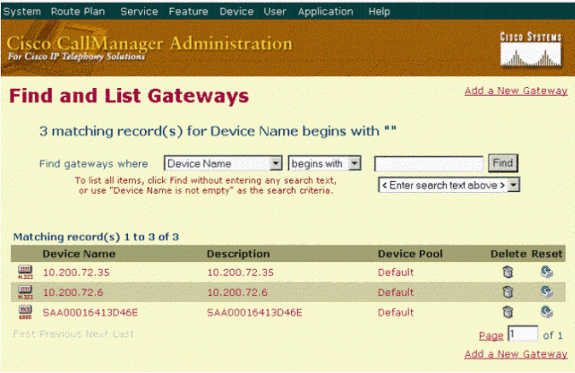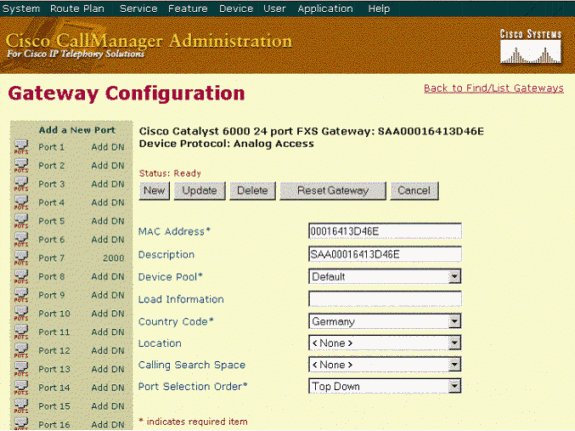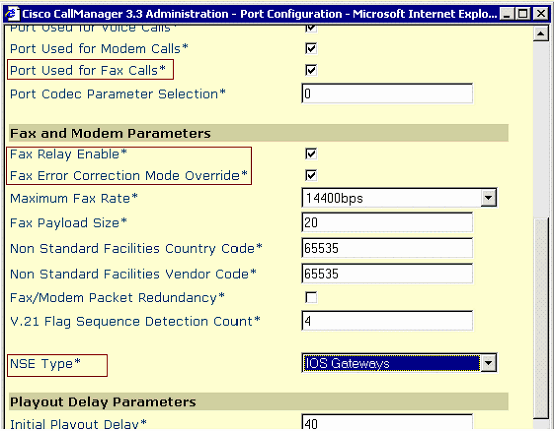Fax Configuration on a Cisco WS-X6624 with an H.323 Gateway
Available Languages
Contents
Introduction
This document presents available options for the proper operation of faxes in this topology:

In that topology, problems might arise due to a mismatch between the two fax modes that the gateways are running. For the fax to be successful, the two gateways must negotiate the same fax mode. By default, a Cisco router and gateway use Cisco fax-relay negotiation (except the 5350 and 5400, on which Cisco fax relay is not supported). However, as of the 3.010 load for WS-X6624 (A002A3A0), the default fax mode is fax pass-through. This document shows how to modify the settings on both devices to get them synchronized.
With Cisco IOS® Software Release 12.2(11)T1, load 47 on a 6608 or load 41 on a 6624, and with Cisco IOS Software Release 1.2(1) on a VG248—voice, Cisco fax relay, and modem pass-through should inter-operate. Prior to those releases, only voice and Cisco fax relay are supported between IOS and non-IOS voice platforms, due to incompatibility.
Prerequisites
Requirements
Readers of this document should be aware that there are several techniques to pass fax calls across a Packet Telephony network on Cisco IOS gateways. These techniques include:
-
Cisco proprietary Fax Relay
-
T.38 Fax Relay
-
Fax Pass-Through
-
Fax Upspeed
-
T.37 Fax Store and Forward
Components Used
The information in this document is based on these software and hardware versions:
-
Cisco CallManager versions 3.x and 4.x
-
24-port FXS blade
Note: The Catalyst 6000 24-Port FXS Analog Module is now in End-of-Life (EOL) stage. Customers that need FXS analog interfaces should now use the Cisco Communication Media Module (CMM). Refer to End-of-Sale and End-of-Life for Cisco Catalyst 6000 24-Port FXS Analog Module.
-
Refer to the Fax Support Matrix section of Cisco AVVID Gateway Support for Fax Relay and Fax Pass-Through for further information about gateways.
The information in this document was created from the devices in a specific lab environment. All of the devices used in this document started with a cleared (default) configuration. If your network is live, make sure that you understand the potential impact of any command.
Conventions
For more information on document conventions, refer to the Cisco Technical Tips Conventions.
Definitions
Fax Relay—Cisco fax relay does not involve Cisco CallManager; it is a gateway-controlled fax mode. Most faxes are processed in the digital signal processors (DSPs) and require only packet switching from the main processor (CPU) and some limited signaling, to switch to fax mode. In fax relay mode, the gateways terminate the T.30 fax signaling.
Fax Pass-Through—Although fax calls are not distinguished from voice calls that use fax pass-through, some functions are disabled, such as compression, echo cancellation, high-pass filter, and voice activity detection (VAD). Because the fax is handled like a voice call, the gateway uses the G.711 codec for fax pass-through transmission. All Cisco voice gateways support fax pass-through.
To Configure the FXS Port for Fax Relay
Use this procedure to configure the Foreign Exchange Station (FXS) port for fax relay:
-
Open the Cisco CallManager Administration panel.

-
Click the 24-port FXS blade configured on your Cisco CallManager.

-
Click the POTS icon next to the port, to select the port that is in use (the port to which your fax has been connected).
The Product Specific Configuration section appears.
-
Verify that Port Used for Fax Calls is checked.
-
For Cisco fax relay, check Fax Relay Enable in the Fax and Modem Parameters area.
-
For modem pass-through, set the NSE Type field to IOS Gateway mode in the Fax and Modem Parameters area.

Note: This configuration supports voice, Cisco fax relay, and modem pass-through between a VG248, 6608, or 6624 and Cisco IOS gateways (with the exception of the AS5350 and AS5400, which do not support Cisco fax relay).
-
Router Configuration
On the router used for the fax detection application, ensure that you have installed at least the minimum version of Cisco IOS software that is listed in Platform Support for Fax Services.
To Configure the H.323 Gateway for Cisco Fax Relay
To configure fax relay when the default G.729 codec is used, the fax-rate command must be set for 9600 or 14400 baud. When G.711 is used, this command is not required.
dial-peer voice 1 voip destination-pattern 2000 session target ipv4:10.200.72.37 fax protocol cisco (default) fax-relay ecm disable (optional) fax nsf <000000> (optional) fax-rate <1440> bytes <20> (optional)
To Configure the H.323 Gateway for Fax Pass-Through
To configure fax pass-through, you must configure the matching Voice over IP (VoIP) dial peer:
dial-peer voice 1 voip destination-pattern 2000 session target ipv4:10.200.72.37 modem passthrough nse payload-type 100 codec G711ulow fax rate disable
To Configure the MGCP Gateway for Cisco Fax Relay
Issue these commands in global configuration mode, to set and configure Cisco fax relay:
ccm-manager fax protocol cisco (default) mgcp fax t38 inhibit
To Configure the MGCP Gateway for Fax Pass-Through
Issue these commands in global configuration mode, to set Cisco fax relay and to configure fax pass-through:
no ccm-manager fax protocol cisco mgcp modem passthrough voip mode nse mgcp modem passthrough voip codec g711ulaw
Troubleshooting
Use this procedure to troubleshoot your configuration:
-
Verify that you can make normal voice calls to the FXS port where the fax is connected.
This is an important step, because it ensures that the signaling works properly.
-
For Cisco CallManager versions earlier than 3.0.11, verify that the load on the 6624 is A002A3A0.
-
On the H.323 gateway, run Cisco IOS Software Release 12.1(3)T or later for Cisco fax relay, and run Cisco IOS Software Release 12.2(11)T or later for fax pass-through.
-
If you are running in Cisco fax relay mode and you are in the fax disconnect after it, add the fax-relay ecm disable command to start transmission.
-
Configure your fax machine to pick up the call after the first ring.
-
Every effort should be made to minimize these types of problems:
-
Loss—Fax and modem traffic require an essentially lossless transport.
-
Delay
-
Delay Variation (Jitter)
Refer to the Solution Reference Network Designs and to the Configuration Considerations section of the Fax Relay Troubleshooting Guide for more information.
-
-
Disable Call Waiting on all dedicated fax ports.
Related Information
Revision History
| Revision | Publish Date | Comments |
|---|---|---|
1.0 |
22-Oct-2008 |
Initial Release |
Contact Cisco
- Open a Support Case

- (Requires a Cisco Service Contract)



 Feedback
Feedback